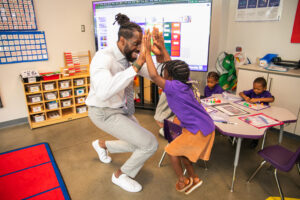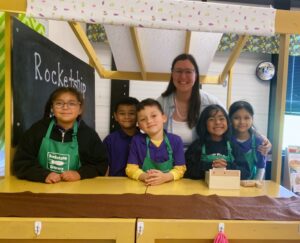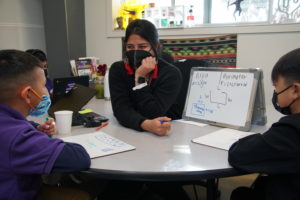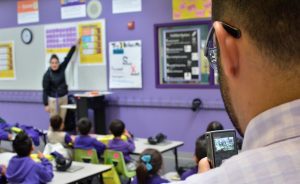
6 Virtual Teaching Tips for Multilingual Learners
Brianna Gargano, Multilingual Specialist, Rocketship Nashville Northeast Elementary
“Okay so we are going to start something new. It is called Virtual Learning. Let’s start by practicing how to mute and unmute. Okay, everyone unmute in 3,2,1. Great! Rodrigo gets a dojo point, Amiah gets a dojo point. Derek, unmute, please. Try it. Derek, yes, the button that looks like a microphone? Oh, nevermind. Forget it. You’re okay!”
This is the sound of zoom classes all across the country.
For the last seven months, we have experienced teaching in a new, creative way that has opened up the box of possibilities for this next generation to use the skills of technology and apply it through academics like never before. However, to say this is equitable for all learners would be a fallacy.
As an English as a Second Language Specialist, I find myself researching where my students fall in the data concerning US Schools. An average of 10.1% of students are multilingual students, formerly known as English Language Learners (ELL) or English Second Language students (ESL). For teachers in Tennessee, 4.6% of students are multilingual. A small amount, perhaps, but what happens when we leave the 10.1% percent behind due to a language barrier?
Here are a few tips to ensure your distance learning lessons are accessible for multilingual learners.
1. Identify a Language Barrier
How do you identify a language barrier, and contrast that barrier from an academic holdback? Simple. Ask in their language, use visuals, or reword the task to be more student-friendly with tier 1 words to ensure the student understands what they’re being asked to do. If the task becomes more accessible, it is a language barrier. If the task is harder or stays the same, it is both.
We often see students struggle in class when their English-speaking peers are working on a task. Then, the camera pans to the multilingual student who is silently doodling their name over and over because it is, quite literally, the only thing they have access to on the paper. When I walk over, I notice that there are several eraser marks and faded writing of another language written in the answer box, but had been erased prior to me hovering over.
2. Use Cognates to Create Clarity
I notice two things: 1) this student has no idea what has been put in front of them, and 2) this student can read and write in their first language. This pushes me to ask the student to use cognates (words that share the same parent language and thus look similar on paper due to spelling or sound the same phonetically). This strategy is best used for students who are new to our country and can read and write in their first language. 40% of words in English have Spanish cognates and while this only works for some languages, this is helpful for the 80% of Latinx students that comprise our 10.1% overall multilingual student population in the US.
3. Use Total Physical Response (TPR) to Make Concepts Stick
Another strategy that is a favorite of all theatre majors is TPR or Total Physical Response. This strategy has three parts and has to meet the criteria before being used in a rigorous, inclusive setting: manageable, meaningful, and joyful.
To start, pick a set of words or just one word, think about the definition, choose a small (waist up) movement, move no more than 3 seconds, and make sure it is taught in the most joyful way possible.
“Okay, show me osmosis in one, two, three!” Osmosis means…..moving through water…” all while doing the movement. When a student is wanting to use a word, cue them up by doing the movement. Then, their brain will activate the meaning of the word, while meeting them where they are linguistically.
A good example of this is a letter names and sounds video created by one of our teachers that has been used throughout our school and has a proven success rate of 40% LNS (letter names and sounds) mastered in September through virtual learning alone.
4. Invite Alternative Ways to Learn with Thinking Maps
There are 8 ways our brains process information in eight different ways: defining, describing, comparing/contrasting, sequencing, cause, and effect, identifying, and analogies. Multilingual students are making room for a new language to be acquired while still developing their first language. This is why we introduced thinking maps into our curriculum.
A third-party study showed that using thinking maps in elementary and middle school had evidence of 1.8 times more likely to surpass district growth in reading, and 2.7 times more likely in math. Every week I’m given the opportunity to showcase a strategy to use with our multilingual students each week. During the month of September, we incorporated thinking maps into grade levels K through 4.
Here we distributed imagery thinking maps where students could dissect and map out words from a text they had read. Each bubble represented a sense used in each word. This changed the game for teaching the unit that was meant to be given orally. This gave students the hands-on experience they deserve in learning-even reading!
In math, students used a tree map to break down numbers to expanded form. There are many ways to utilize thinking maps. Thinking maps have transitioned from being “another thing” to “the thing” for teachers, and that is how you know you have truly collaborated with your school team.
Overall, multilingual students come to us from different countries, carrying baggage from whatever they left behind. We know that in this political climate, they enter the country feeling unwelcome, and in school, carry an even heavier suitcase as they yearn to fit in while not yet feeling comfortable speaking the language. Using terms such as “multilingual” instead of English Learner changes the narrative from “This is the language of learning.” to “This is another language you get to learn while you’re here.” So, when I think about the 10.1%, I don’t see a number. I see names and faces, and I won’t leave them behind.
5. Use color coding to help students differentiate content.
Associating colors with certain content helps students quickly distinguish between different concepts and ideas. How does this work? Fill in words, numbers, and shapes particular colors that will help students remember the concept.
6. Use virtual cooperative strip paragraphs in your lessons.
A virtual strip paragraph is a paragraph composed of sentences created by student groups, where the students piece together one paragraph on a certain topic. How does it work? Students create a sentence in their groups on a topic, and when they are brought back together they determine which order the sentences will go in for the paragraph to flow best. Why is it effective? Well, all domains go to work when working with an intentional group. Writing practice, and explanatory speaking. It’s also accessible for all students and engaging.
I hope these tips help! If you want to explore more ways you can make lessons accessible for students with exceptionalities and diverse needs, check out this webinar below.
Anonymous. (2020, February 18). Language Acquisition: An Overview. Retrieved October 12, 2020, from https://www.colorincolorado.org/article/language-acquisition-overview
English Language Learners in Public Schools. (2020, May). Retrieved October 11, 2020, from https://nces.ed.gov/programs/coe/indicator_cgf.asp
The Effects of Thinking Maps in Raising Student Achievement: A Retrospective Study of Outcomes from Implementing Schools. (n.d.). Retrieved October 12, 2020, from https://www.thinkingmaps.com/effects-of-thinking-maps/
Published on December 7, 2020
Read more stories about: Pay It Forward.
In the Classroom
How to Foster a Growth Mindset in the Classroom
Jeremiah Davis, Paraprofessional, Rocketship Dream Community Prep | April 10, 2025
Learn how to cultivate reflection, embrace challenges, and promote perseverance in yourself and in your students.
Read more ⟩How to Improve School Culture
Jeremiah Davis, Paraprofessional, Rocketship Dream Community Prep | March 3, 2025
Ready to ramp up moral at your school? Weave these nine celebrations into your school year!
Read more ⟩How Coaching in Schools Improves Outcomes
Rockesthip Public Schools | Feb 4, 2025
Learn how live coaching and weekly feedback sessions can help your teachers feel more supported year round!
Read more ⟩Parent Conference Tips for First Year Teachers
Jeremiah Davis, Paraprofessional, Rocketship Dream Community Prep | January 6, 2025
Looking for top parent conference tips? Prepare with advice from our educators.
Read more ⟩First Year Teacher? Here are Five Mistakes to Avoid.
Jeremiah Davis, Paraprofessional, Rocketship Dream Community Prep | November 1, 2024
See what mistakes most first year teachers make and how you can get ahead this school year with some simple tips from a fellow educator.
Read more ⟩3 Classroom Systems New Teachers Swear By
Rocketship Public Schools | Sept. 30, 2024
As a first year teacher, establishing a smooth and productive classroom environment can feel a tad overwhelming. Thankfully, these simple strategies can go a long way.
Read more ⟩How Co-Teacher Collaboration Can Benefit Your Classroom
Featuring Alejandra Chavez, Education Specialist at Rocketship Mosaic Elementary | June 10, 2024
Hear from Ms. Aly about how a small team of educators can make a big difference in student outcomes through thoughtful planning, focused collaboration, and personalized accommodations. Ms. Aly was one of our highest-performing educators in California for the 23-24 school year.
Read more ⟩How to Spark Joy in ESL Classrooms with a Multilingual Learning Clubhouse
Featuring Ms. Amy De La Rosa, Multilingual Specialist, Nashville Northeast Elementary | June 1, 2023
Listen in to an audio interview with Amy De La Rosa, a Multilingual Specialist who has worked as an educator for over 14 years and found an innovative way to help her students learn English in a more accelerated, playful way.
Read more ⟩Supporting Parents of Multilingual Students in Family/Teacher Conferences
Emma Volpe, Rocketship United Academy | June 1, 2022
Get thoughtful insight on how to create a more inclusive family-teacher conference environment.
Read more ⟩5 Ways to Strengthen Relationships in the Classroom
James Cross, Assistant Principal, Rocketship Nashville Northeast Elementary | February 20, 2022
A new age of education calls for a new level of connection. Here are some key tips to strengthen relationships in your classroom this school year.
Read more ⟩5 Ways School Leaders Can Coach and Support Teachers
Eesir Kaur, Director of Professional Development | October 15, 2020
Are you a school leader looking to coach your teachers more effectively? Here's what works for us.
Read more ⟩














